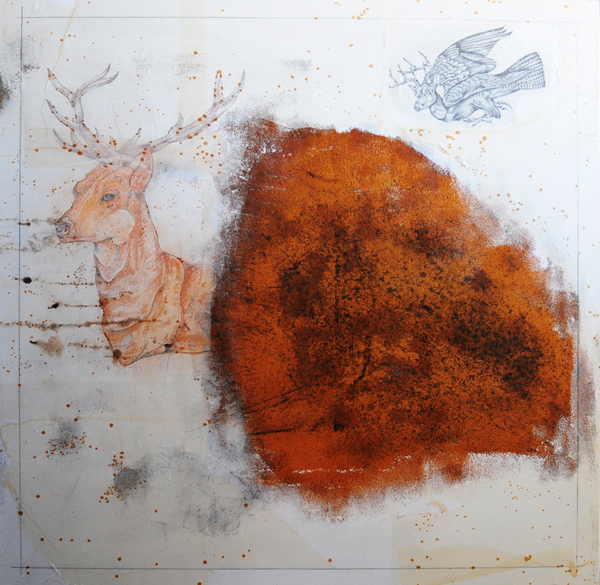Fabrizio Cotognini
dal 18/11/2014 al 9/2/2015
Segnalato da
18/11/2014
Fabrizio Cotognini
Prometeogallery, Milano
Havel Havalim. Cotognini offre la sua riflessione sull'effimera condizione dell'esistenza umana, attorno a temi universali come la bellezza, la morte, la politica, la fede, la violenza, il progresso scientifico, l'illusione dell'immortalita', la morte.

---- english below
Hèvel havalim dice il Predicatore del Qohèlet; Vanitas vanitatum et omnia vanitas traduce Gerolamo; spreco di sprechi il tutto è spreco azzarda Erri de Luca. Hèvel havalim, la più grande vanitas, il più grave degli sprechi, è il titolo della personale con cui Fabrizio Cotognini offre la sua riflessione sull'effimera condizione dell'esistenza umana, attorno a temi universali come la bellezza, la morte, la politica, la fede, la violenza, il progresso scientifico, l'illusione dell'immortalità, la morte. E le tavole che sono sempre altro da quello che sembrano, e gli oggetti e gli strumenti manipolati nelle loro funzioni, e gli elementi della natura che forse sono veri, forse sono finti, e il libro, il libro lungo, il libro che avvolge e che parla dolore, tutto questo dice vanitas, dice spreco, Memento Mori, hodie mihi cras tibi.
Il trionfo della morte della società dei consumi e la danza macabra dei mass-media hanno un sapore tecnologico e antico. Nihil sub sole novum, dice ancora il Predicatore del Qohèlet, non c’è nulla di antico sotto il sole…chi legge le mie parole le sta inventando, recita Borges. Ecco il senso profondo della mostra di Cotognini, il fulcro attorno al quale ruota, da tempo, la sua ricerca artistica: la citazione. L’artista propone un viaggio nei territori della cultura visiva del nostro tempo, coniuga all'interno di uno stesso perimetro visivo, l'arcaico e l'attuale, induce l'individuo all'interno di uno scenario di affascinanti macchinazioni, cinetismi, anamorfosi, proiezioni geometriche che reinventano alcuni punti cardine della storia dell'arte. Egli tratta temi universali riscritti nella contemporaneità seguendoli nel loro percorso di evoluzione nel corso del tempo. Ed ecco, tra il ricordo e l'esplorazione, il gioco delle citazioni, che guarda alle opere dei grandi (da Caravaggio, a Piero della Francesca, a Mantegna), e alla cultura popolare (stampe, incisioni e pubblicità); ecco il ricorso alla simbologia naturale che spesso rende visibili dinamiche della vita dell'uomo: fiori, piante, animali, insetti, accompagnano frammenti, ritagli di immagini appartenenti alla storia dell'arte che, sottratti alla loro condizione formale, fungono da viatico per l'elaborazione di un nuovo immaginario, di una nuova opera. Come le parole di Borges che chi le legge le inventa, così le immagini di Cotognini si fanno comporre da chi le guarda in un percorso che l’artista, sin-esteta puro, racconta vedendo i suoni, sentendo i colori, suggerendo forme e movimenti.
Fabio Ionni
--- english
Hèvel havalim says the Preacher of the Kohelet; Vanitas vanitatum et omnia vanitas translates Saint Jerome; spreco di sprechi il tutto è spreco (Utterly meaningless! Everything is meaningless) dares Erri de Luca. Hèvel havalim, la più grande vanitas, il più grave degli sprechi, (Hèvel havalim, the greatest vanitas, the gravest meaninglessness) is the title of the solo exhibition with which Fabrizio Cotognini offers his reflection on the fleeting condition of human existence around universal themes such as beauty, death, politics, faith, violence, scientific progress, the illusion of immortality, death. And the tablets that are always different from what they seem to be, and the objects and instruments manipulated in their functions, and the elements of nature that perhaps are real, perhaps are fake, and the book, the long book, the book that envelops and that speaks about suffering, all this is vanitas, meaninglessness, Memento Mori, hodie mihi cras tibi.
The triumph of death in a consumer society and the macabre dance by the mass media have a technological and ancient flavor. Nihil sub sole novum, says, too, the Preacher of the Qohèlet, there is nothing else so ancient under the sun… he who reads my words is inventing them, recites Borges. Here is the profound sense of Cotognini’s exhibition, the pivot around which his artistic research has been rotating for some time: quotes. The artist proposes a journey in the territories of the visual culture of our times, conjugates the archaic and the current inside a sole visual perimeter, induces the individual inside in a scenario of fascinating intrigues, Cinetism, anamorphoses, geometric projections that re-invent some of the cornerstones of the history of art. He treats universal themes rewritten in contemporary times, following them along their evolutionary path. And so – between memory and exploration – comes the game of quotes that looks to the works by the greats (from Caravaggio to Pierodella Francesca, to Mantegna), and to popular culture (prints, engravings and advertising). So comes recourse to natural symbols that often render the dynamics of man’s life visible: flowers, plants, animals, insects accompany fragments, picture cut-outs belonging to the history of art which, removed from their formal context, act as path for the elaboration of a new imagination, of a new work. Like the words of Borges that are invented by the person reading them, so the images of Cotognini let themselves be composed by the person viewing them in an itinerary that the artist, pure synetheste, describes by seeing the sounds, hearing the colors, suggesting forms and movements.
Fabio Ionni
Inaugurazione 19 novembre ore 19
Prometeogallery di Ida Pisani
via G. Ventura, 3 Milano
lun-ven 10-19
ingresso libero



